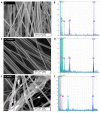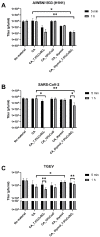Antibacterial and Antiviral Effects of Ag, Cu and Zn Metals, Respective Nanoparticles and Filter Materials Thereof against Coronavirus SARS-CoV-2 and Influenza A Virus
- PMID: 36559043
- PMCID: PMC9785359
- DOI: 10.3390/pharmaceutics14122549
Antibacterial and Antiviral Effects of Ag, Cu and Zn Metals, Respective Nanoparticles and Filter Materials Thereof against Coronavirus SARS-CoV-2 and Influenza A Virus
Abstract
Due to the high prevalence of infectious diseases and their concurrent outbreaks, there is a high interest in developing novel materials with antimicrobial properties. Antibacterial and antiviral properties of a range of metal-based nanoparticles (NPs) are a promising means to fight airborne diseases caused by viruses and bacteria. The aim of this study was to test antimicrobial metals and metal-based nanoparticles efficacy against three viruses, namely influenza A virus (H1N1; A/WSN/1933) and coronaviruses TGEV and SARS-CoV-2; and two bacteria, Escherichia coli and Staphylococcus aureus. The efficacy of ZnO, CuO, and Ag NPs and their respective metal salts, i.e., ZnSO4, CuSO4, and AgNO3, was evaluated in suspensions, and the compounds with the highest antiviral efficacy were chosen for incorporation into fibers of cellulose acetate (CA), using electrospinning to produce filter materials for face masks. Among the tested compounds, CuSO4 demonstrated the highest efficacy against influenza A virus and SARS-CoV-2 (1 h IC50 1.395 mg/L and 0.45 mg/L, respectively), followed by Zn salt and Ag salt. Therefore, Cu compounds were selected for incorporation into CA fibers to produce antiviral and antibacterial filter materials for face masks. CA fibers comprising CuSO4 decreased SARS-CoV-2 titer by 0.38 logarithms and influenza A virus titer by 1.08 logarithms after 5 min of contact; after 1 h of contact, SARS-COV-2 virus was completely inactivated. Developed CuO- and CuSO4-based filter materials also efficiently inactivated the bacteria Escherichia coli and Staphylococcus aureus. The metal NPs and respective metal salts were potent antibacterial and antiviral compounds that were successfully incorporated into the filter materials of face masks. New antibacterial and antiviral materials developed and characterized in this study are crucial in the context of the ongoing SARS-CoV-2 pandemic and beyond.
Keywords: copper oxide; coronavirus; electrospinning; face masks; silver; toxicity; zinc oxide.
Conflict of interest statement
The authors declare no conflict of interest.
Figures




Similar articles
-
Questioning ZnO, Ag, and Ag/ZnO nanoparticles as antimicrobial agents for textiles: Do they guarantee total protection against bacteria and SARS-CoV-2?J Photochem Photobiol B. 2022 Sep;234:112538. doi: 10.1016/j.jphotobiol.2022.112538. Epub 2022 Aug 4. J Photochem Photobiol B. 2022. PMID: 35964336 Free PMC article.
-
Spark Discharge Aerosol-Generated Copper-Based Nanoparticles: Structural & Optical Properties; Application on the Antiviral (SARS-CoV-2) and Antibacterial Improvement of Face Masks.Chempluschem. 2024 Aug;89(8):e202400194. doi: 10.1002/cplu.202400194. Epub 2024 May 24. Chempluschem. 2024. PMID: 38646973
-
Lignin-facilitated growth of Ag/CuNPs on surface-activated polyacryloamidoxime nanofibers for superior antibacterial activity with improved biocompatibility.Int J Biol Macromol. 2023 Jul 1;242(Pt 2):124945. doi: 10.1016/j.ijbiomac.2023.124945. Epub 2023 May 19. Int J Biol Macromol. 2023. PMID: 37211079
-
Silver, copper and copper oxide nanoparticles in the fight against human viruses: progress and perspectives.Crit Rev Biotechnol. 2022 May;42(3):431-449. doi: 10.1080/07388551.2021.1939260. Epub 2021 Jul 7. Crit Rev Biotechnol. 2022. PMID: 34233551 Review.
-
Physical interventions to interrupt or reduce the spread of respiratory viruses.Cochrane Database Syst Rev. 2020 Nov 20;11(11):CD006207. doi: 10.1002/14651858.CD006207.pub5. Cochrane Database Syst Rev. 2020. Update in: Cochrane Database Syst Rev. 2023 Jan 30;1:CD006207. doi: 10.1002/14651858.CD006207.pub6. PMID: 33215698 Free PMC article. Updated.
Cited by
-
Sputtering-Deposited Ultra-Thin Ag-Cu Films on Non-Woven Fabrics for Face Masks with Antimicrobial Function and Breath NOx Response.Materials (Basel). 2024 Mar 29;17(7):1574. doi: 10.3390/ma17071574. Materials (Basel). 2024. PMID: 38612088 Free PMC article.
-
A Review on Reinforcements and Additives in Starch-Based Composites for Food Packaging.Polymers (Basel). 2023 Jul 7;15(13):2972. doi: 10.3390/polym15132972. Polymers (Basel). 2023. PMID: 37447617 Free PMC article. Review.
-
Broad Adaptability of Coronavirus Adhesion Revealed from the Complementary Surface Affinity of Membrane and Spikes.Adv Sci (Weinh). 2024 Nov;11(41):e2404186. doi: 10.1002/advs.202404186. Epub 2024 Sep 4. Adv Sci (Weinh). 2024. PMID: 39231361 Free PMC article.
-
Synthesis and Antiviral Activity of Nanowire Polymers Activated with Ag, Zn, and Cu Nanoclusters.Pharmaceutics. 2025 Jul 6;17(7):887. doi: 10.3390/pharmaceutics17070887. Pharmaceutics. 2025. PMID: 40733096 Free PMC article.
-
Enhanced and copper concentration dependent virucidal effect against SARS-CoV-2 of electrospun poly(vinylidene difluoride) filter materials.iScience. 2024 Apr 27;27(6):109835. doi: 10.1016/j.isci.2024.109835. eCollection 2024 Jun 21. iScience. 2024. PMID: 38799576 Free PMC article.
References
-
- Menachery V.D., Yount B.L., Debbink K., Agnihothram S., Gralinski L.E., Plante J.A., Graham R.L., Scobey T., Ge X.Y., Donaldson E.F., et al. A SARS-like Cluster of Circulating Bat Coronaviruses Shows Potential for Human Emergence. Nat. Med. 2015;21:1508–1513. doi: 10.1038/nm.3985. - DOI - PMC - PubMed
Grants and funding
LinkOut - more resources
Full Text Sources
Miscellaneous

